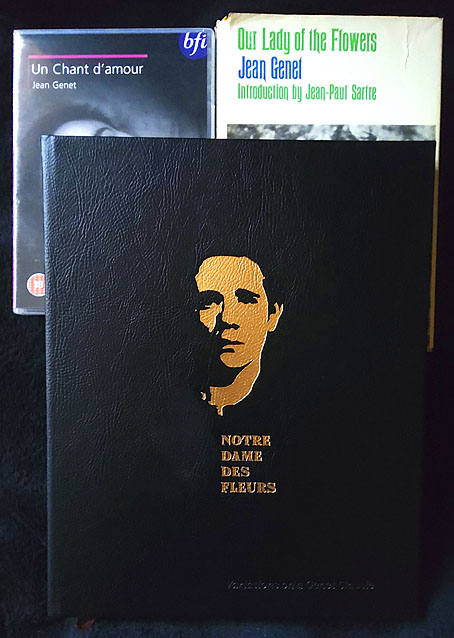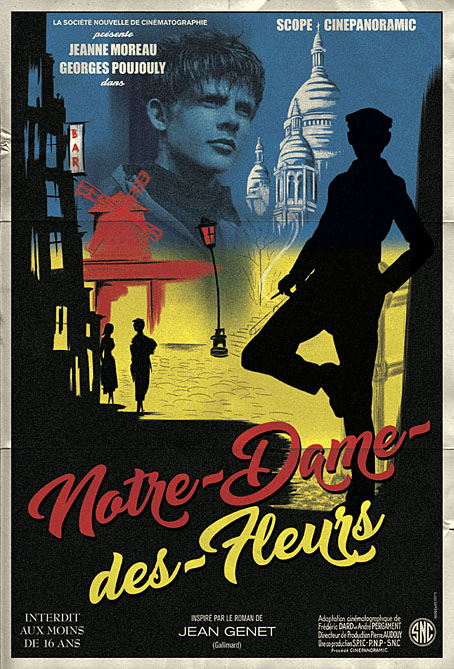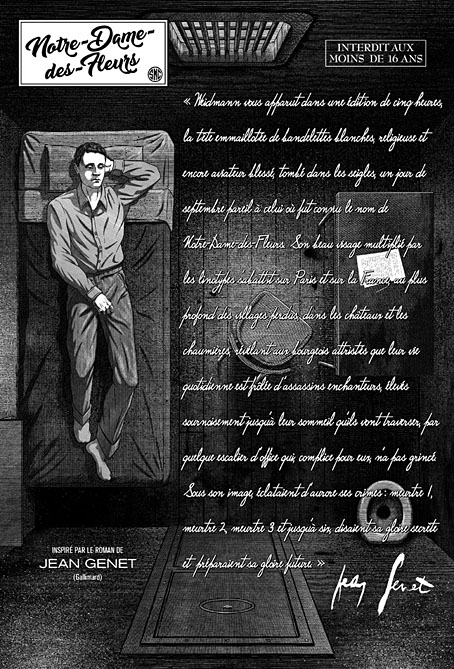Another week, another book release. Notre Dame des Fleurs is a collection of artistic responses to Jean Genet’s debut novel, compiled and published by Jan van Rijn, for which I contributed three pieces:
Based on the English translation of the unabridged original edition, published in 1949 by Edition Paul Morihien, it is by no means a consistent illustration of the book nor is it a cohesive interpretation in form of a graphic novel. It is a truly personal collection that throws highlights on a beautiful piece of literature, printed in a run of 150 signed and numbered copies. The participating artists in alphabetical order: Michael Ampersant – Antoine Bernhart – Wim Beullens – Susie Bright – John Coulthart – Lauri Elexsen – Rinaldo Hopf – Anja Molendijk – Brane Mozetic – John Thomas Paradiso – Rex – Apollonia Saintclair – Jan van Rijn – Vilela Valentin
Genet’s novel caused a considerable stir when it was first published in France in 1943. Part memoir, part fiction, part masturbation aid, the book was famously written by Genet on sheets of wrapping paper in his Paris prison cell, and is probably the first account of homosexual lives—especially of homosexual erotic lives—lived on their own terms, without any apologies made to straight society or, for that matter, the straight reader. (“Straight” here applies to criminality as much as sexuality.) Antecedents exist, like Teleny Or the Reverse of the Medal, but Teleny is more assertively pornographic, which means it wanders into the fantasy world that porn always creates, a place where desire is everything and introspection doesn’t exist. Genet was writing about the people he knew in Paris before the war, the thieves and pimps and male prostitutes of Montmartre, and doing so in a manner that had to be considered as literature however transgressive the content might be for the literary establishment of the day.
The unique qualities of the novel present difficulties for an illustrator. Literary fiction tends to look inside its characters much more than genre fiction, summoning thoughts, moods and feelings which resist easy depiction in a visual form. I’d first been asked to consider illustrating Notre Dame des Fleurs several years ago for a Graphic Classics collection of crime fiction, a request to which I agreed then had to turn down after deciding that the task of condensing the book into a few pages was a near impossibility. For Jan’s book, rather than illustrate a scene or two from the novel I opted for a conceptual approach. My three pages are intended to be promotional materials from a parallel universe in which Notre Dame des Fleurs was made into a French feature film some ten years or so after its publication, complete with hardcore sex scenes. The latter may seem unlikely but Genet was in the vanguard of presenting gay sex on the cinema screen in Un Chant d’Amour, the 26-minute silent film he made in 1950. He subsequently disowned the film, as he disowned—or “forgot”—many of his creations in later years, but it remains a pioneering and influential work.
My imaginary feature has Georges Poujouly and Jeanne Moreau listed as its stars. Poujouly was a child actor in the 1940s with a long career in French cinema; he appeared with Jeanne Moreau in Louis Malle’s Ascenseur pour l’échafaud (1958) where he plays a young petty criminal who ends up as a murderer, so he seemed a good choice for Genet’s teenage killer to whom the author gives the name Our Lady of the Flowers. As for Jeanne Moreau, she’d have to be in this somewhere. She was a friend of Genet’s who starred in two films based on his writings: Mademoiselle (1966) and Querelle (1982). In 2010 she also recorded an album with Étienne Daho of readings from Genet’s poems, Le Condamné à Mort, a collection which opens with the dedication from Notre Dame des Fleurs. So I have a poster for the film, followed by a still showing Genet in his prison cell together with the words that open the novel. My third page—which I’ll reserve for the book’s purchasers—features a series of stills showing sexual encounters based on rare photos of French gay porn from around 1900. These are somewhat anachronistic but they connect the drawings and the novel to a wider and older sphere of illicit sexuality. And given their rarity, it’s likely that copies of the photos would have still have been circulating in the Paris of the 1930s. Many of the other contributions to Jan’s book are just as wayward, featuring sex scenes or homoerotic portraits that are responses to Genet’s text rather than illustrations. What Genet himself would have made of all this attention is anybody’s guess. I can imagine a shrug of indifference or a scowl of disdain. But he was a friend of artists as temperamentally different as Jean Cocteau, Leonor Fini and Alberto Giacometti so he may have appreciated some of the depictions of male flesh and male sexuality.
For Genet enthusiasts this is a beautiful production, with a reclaimed leather cover and colour printing throughout. Copies may be ordered here, from Lowenherz (Austria), or Les Mots À La Bouche (Paris). The interior of the book may be seen here.
Update: added more sales links.
Elsewhere on { feuilleton }
• The gay artists archive
Previously on { feuilleton }
• Genet art
• Flowers: A Pantomime for Jean Genet
• Querelle de Brest
• Jean Genet, 1981
• Un Chant d’Amour (nouveau)
• Jean Genet… ‘The Courtesy of Objects’
• Querelle again
• Saint Genet
• Teleny, Or the Reverse of the Medal
• Emil Cadoo
• Exterface
• Penguin Labyrinths and the Thief’s Journal
• Un Chant d’Amour by Jean Genet




The movie poster is wonderful.
Thanks, Jim.
This work is wonderful John, and your poster approach is top shelf.
I have loved Genet since a young boy. I snuck into a theater in LA when I was 15 to see Un Chant d’Amour, and walked out needing to know everything about the maker. It was the awareness of this film, and Genet, that got me hired with Todd Haynes. So in essence I owe Genet a lot.
The Kraut blog was a little confusing, but I think I emailed him correctly about ordering one.
Thanks, Jay. Todd Haynes…wow. I love Velvet Goldmine. I only got to see Poison a couple of years ago, having missed it first time round.